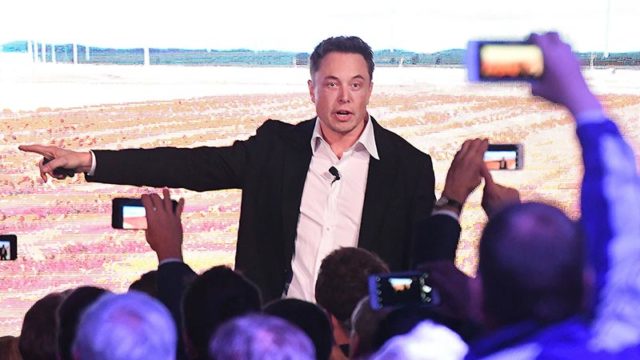Date: Jul 09, 2018

Elon Musk launches the Tesla South Australian stationary storage battery in Adelaide last year. Pic: Getty
“Stationary storage” is a commonly heard buzz word among battery metals investors who hope it could be an even bigger driver of the resources market than electric vehicles.
Stationary storage typically refers to battery storage solutions that use technology such as lead-acid, nickel cadmium or lithium-ion.
The systems can store excess power — including from renewable sources — for use during expensive peak demand periods.
Lead-acid has traditionally been the most common technology — but more efficient technologies such as flow batteries and lithium ion are emerging as a popular option, for example Tesla’s lithium-based PowerWall and Powerpack products aimed at households and businesses.
Infact, while Tesla has struggled with ramping up production of its Model 3 eletric car, stationary storage has been a bright point for the business, boss Elon Musk said at the company annual shareholder meeting last month.
Tesla has deployed 1 GWh of energy storage to date — almost half the 2.3 GWh of stationary storage deployed globally last year.
One GWh is the equivalent of generating 1 billion watts for one hour. Tesla’s first “gigafactory” in Nevada will produce 35 GWh of batteries annually when fully operational — and the company is planning another dozen gigafactories.
Right now Tesla’s car sales ($US2.7 billion for Q1 2018) dwarf its energy business ($US410 million in the same period). But that could change as Tesla works to become a fully-fledged energy company.
“The rate of stationary storage is going to grow exponentially,” Mr Musk said at last month’s shareholder meeting. “For many years to come each incremental year will be about as much as all of the preceding years, which is a crazy, crazy growth rate,” Musk said.
Stationary storage a major driver
The stationary storage story has so far taken a backseat to electric vehicles. But it could become a major driver of ASX-listed lithium stocks — and drive further interest in other energy storage battery metals such as vanadium and zinc.
France-based management consulting agency Arthur D. Little sees the battery market tipping $US90 billion-plus by 2025, up from $US60 billion in 2015.
An increasing reliance on battery storage for renewable energy is driving “enormous” demand, the firm said in recent research report.
In just the past two years, over $US13.7 billion of battery-related investments and acquisitions have been made.
These investments include Japanese chemical company Asahi Kasei’s $2.2 billion buyout of battery separator manufacturer Polypore, the acquisition of battery maker Saft by French oil and gas giant Total, and the creation of an energy storage joint venture company called “Fluence” by AES and Siemens.
Australia leading the way
The Australian government released its “Taking charge: The energy storage opportunity for Australia” report on Friday, which showed that Australia is a leader in energy storage.
“Looking at behind-the-meter, Australia was the biggest residential storage market in the world in 2017, with a tripling of residential storage deployments over the previous year,” said Ravi Manghani, research director for Wood Mackenzie Power and Renewables.
He added that Australia is also turning out to be an important “front-of-the-meter” market.
“In 2017, the South Australian government awarded a 100MW/129MWh battery storage project to French renewable energy developer Neoen, along with Tesla,” Mr Manghani said.
“The system came online in Q1 2018, and as of now is the largest deployed lithium-ion battery system in the world.”
- Subscribe to our daily newsletter
- Bookmark this link for small cap news
- Join our small cap Facebook group
- Follow us on Facebook or Twitter
Before the Labor Party lost the recent election in South Australia it set Australia’s first storage target of 25 per cent of system peak by 2025.
The Victorian government, meanwhile, has launched its own $25 million energy storage initiative and has so far awarded two projects totalling 55MW/80MWh.
“We project that Australia front-of-the-meter storage market will have 2.5GWh of cumulative deployments over the five year period from 2018 to 2025,” Mr Manghani said.
In Europe, the energy storage market grew 49 per cent in 2017 to 589MW of installed capacity.
And the European Association for Storage of Energy predicts the market will grow by a further 85 per cent in 2018 and 2019.

